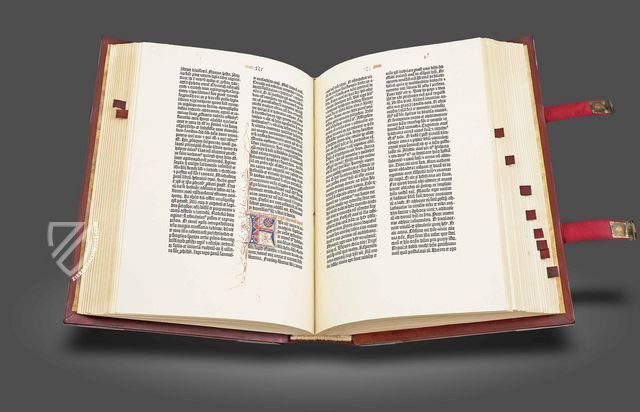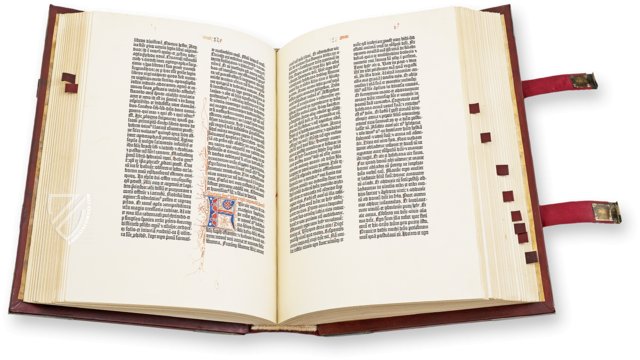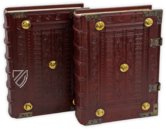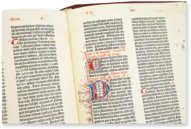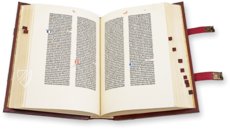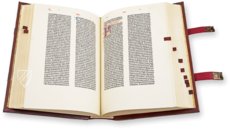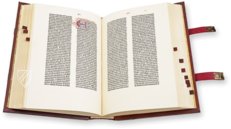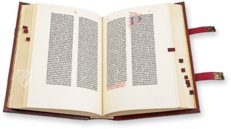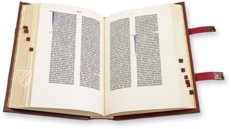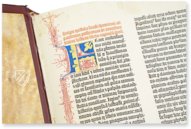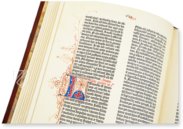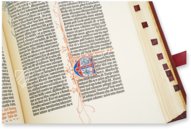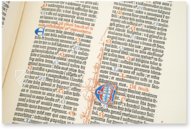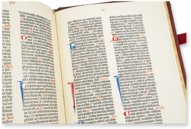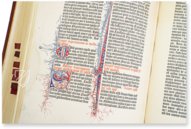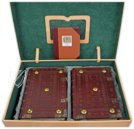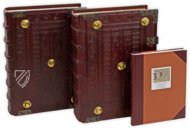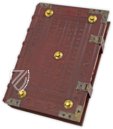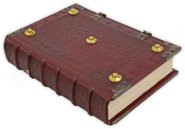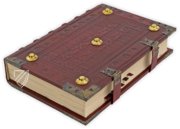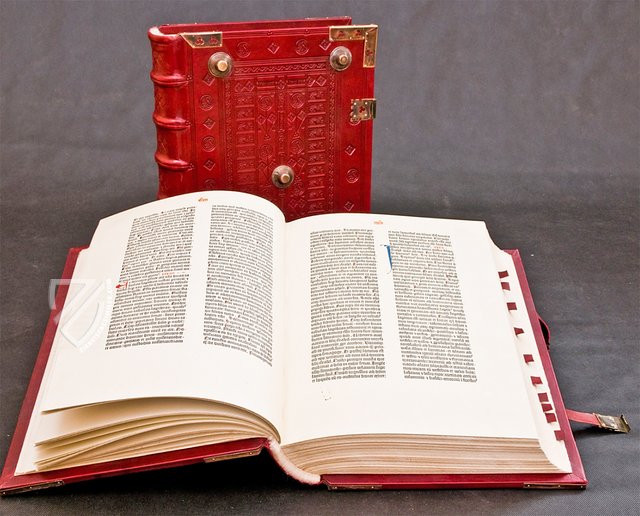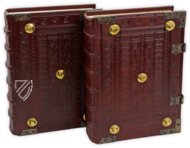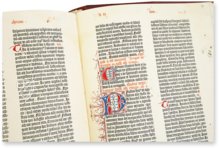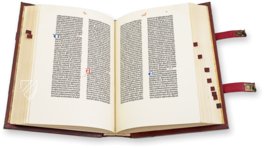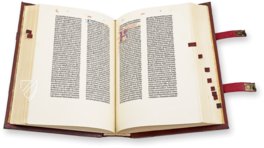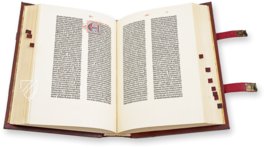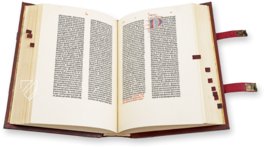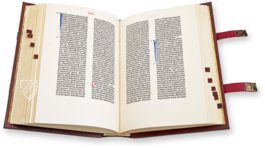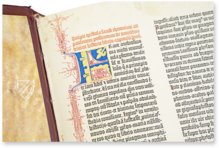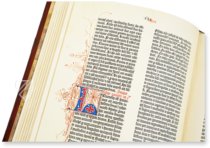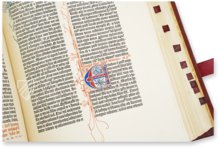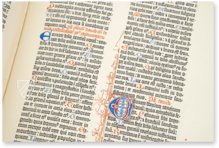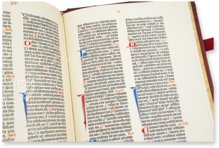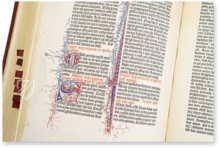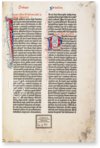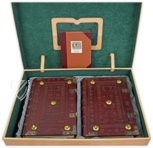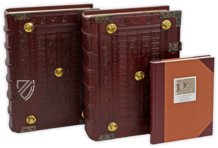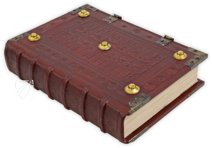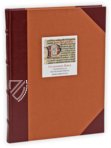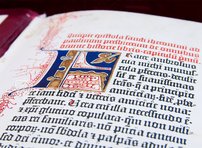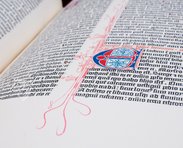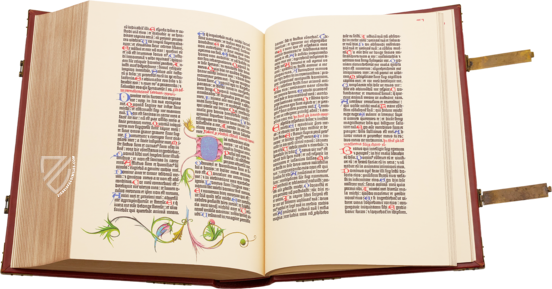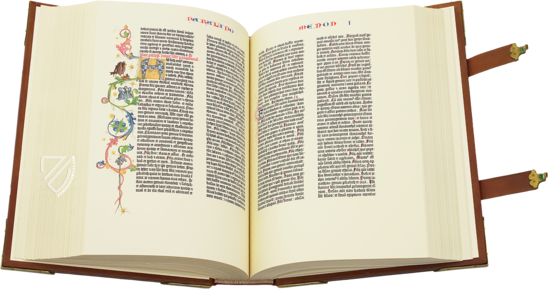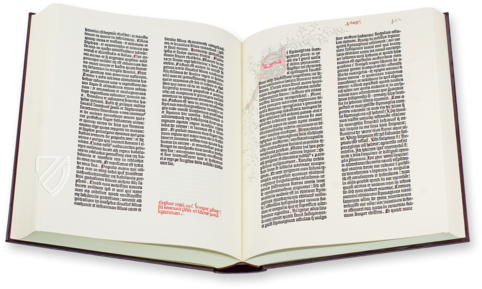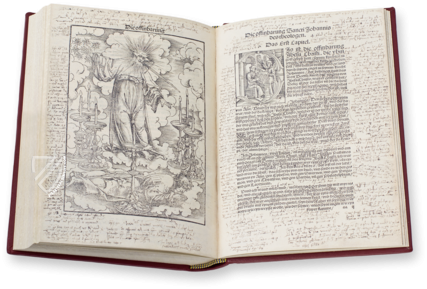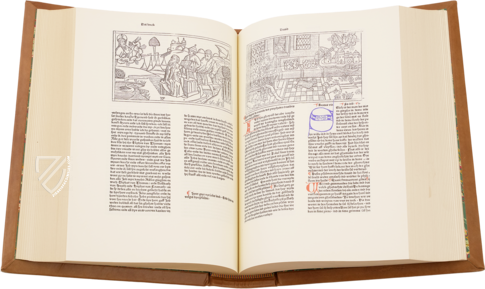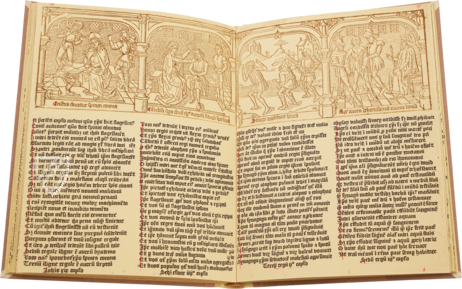Gutenberg Bible - Pelplin copy
(over 10,000€)
Johannes Gutenberg is, aside from the Reformer Martin Luther, the most important German whose name is associated with the transition from the Middle Ages to the modern era. Gutenberg is considered to be the inventor of book printing and the first published of literature worldwide. The famous Gutenberg Bible is the paradigm of the printing process developed by him and numbers today among the most important creations of world literature. A unique illuminated specimen of the Gutenberg Bible can be found today in the library of the Pelplin diocese in Poland. The precious work belongs among the earliest prints of the special Bible and was manufactured in Gutenberg’s Mainz workshop ca. 1453.
Gutenberg Bible - Pelplin copy
One specimen of the 180 printed and 48 surviving two-volume copies of the famous Gutenberg Bible is found in the seminary library of Pelplin in Poland. The valuable early printed book, also known as the Pelplin Bible, was printed between 1452 and 1453 in Gutenberg’s Mainz workshop. The handwritten template for the printed book was the so-called Vulgate, a 4th century translation of the books of the Old and New Testaments by St. Jerome. The Latin text was printed in a close line system on 541 hand decorated and illustrated sheets of paper. The illuminated Pelplin Bible is, just like every other surviving Gutenberg Bible, a gorgeous, high-quality unicum and an absolute treasure for every bibliophile.
Gutenberg’s Legacy
Johannes Gutenberg is regarded as the inventor of modern book printing with moveable metal type and printing press. He was actually the first person who employed the invention of book printing in such a way that it unleashed a revolution in the availability and price of books. He was the first editor or publisher of literature worldwide. The paradigm of his publication method was his printed Bible. Credit is due Gutenberg in particular for having coalesced all of the components of the printing and reproduction of written text into an efficient production process, which facilitated the mechanical production of books for the first time. In the year 1997, Gutenberg’s printed Bible was voted Time-Life Magazine’s most important invention of the second millennium, and the Mainz native was named the “Man of the Millennium” in 1999 by the A&E Network.
A Truly Unique Gutenberg Bible
The Pelplin Bible consists of two volumes, the first of which contains the Old Testament and the second the New Testament. The text pages are arranged in a uniform justification. The harmonious impression of the text pages is the result of the application of various broad letters, ligatures, and abbreviations. Gutenberg chose a particularly large font for his typeface, which is reminiscent of earlier, handwritten liturgical books. Consequently, the biblical text is also legible in low light and from a distance and was intended for use in church. The Bible was furnished with individually colored and gilded decorations and initials according the wishes of the owner subsequent to printing. The illustrators inserted colorful drawings, furnished the book pages with elaborate floral adornment and embellished free spaces around the text with realistic plant tendrils. The Pelplin Bible is a precious unicum like the other specimens of this work.
The Turbulent History of the Pelplin Bible
The Pelplin Bible is not merely special because of its unique illumination. The splendid work can look back on a fascinating trip through the entire world. A patron for the unbelievably costly and precious book has still not been established today. It is known that the book sat long in the Bernardine Monastery in Lubawa, Poland and from there came into the possession of the seminary library at Pelplin in the early 19th century. There it remained for a few decades, whereat it was falsely cataloged and titled in the library’s inventory. The error was first corrected by Paul Schwenke, a royal expert on early printed books, three years before the end of the century. The Pelplin Bible remained in exile for approximately 20 years during the Second World War. During this time, under circumstances straight out of a gripping war film, it left the country, initially going to Paris, then England, and finally across the Atlantic Ocean to Canada. After this turbulent period was over, the work finally returned to Pelplin and is the greatest treasure of the of the museum collection of the local diocese.
Codicology
- Alternative Titles
- Pelpliner Gutenberg-Bibel
Pelplinskiego egzemplarza Biblii Gutenberga
42-wierszowej Biblii Gutenberga
Pelplin Bible
Gutenberg Bible 42-P
Bibbia di Gutenberg
Biblia Gutenberga - Size / Format
- 1,280 pages / 43.0 × 31.5 cm
- Origin
- Germany
- Date
- Ca. 1453
- Epochs
- Style
- Genre
- Language
- Artist / School
- Johannes Gutenberg (ca. 1400–1468) (printer)
Henricus Coster of Lübeck (bookbinder)
Gutenberg Bible - Pelplin copy
“Q” Initial, Prologue, Gospel of Luke
This style of initial was already widely popular in Gothic manuscripts before they were famously featured in many of the finest specimens of the Gutenberg Bible. They were drawn by pen in expensive and wonderfully contrasting red and blue inks. The first printed Bible was presented with blank spaces for initials and decorative marginalia to be added later by hand according to the patron’s own taste, something that had been seamlessly accomplished here with delicate pen strokes.
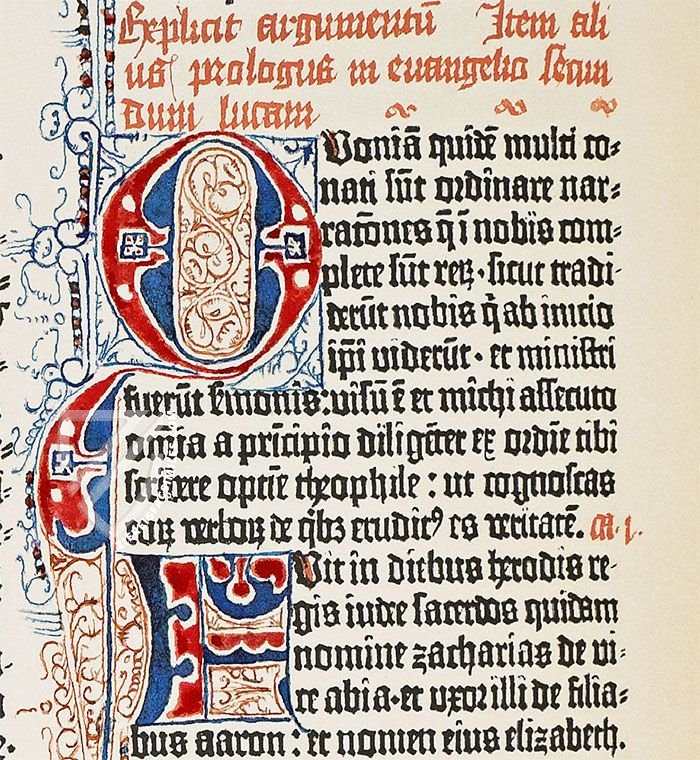
Gutenberg Bible – Pelplin copy
Initial Page – Prologue
The Gutenberg Bible represents a hybrid work combining the new technology of the printed book with traditional illumination from manuscripts. Sometimes printed in red, the Latin text also left spaces for elaborate initials to be completed by hand. The patron of this codex had the opening page of the manuscript embellished with an initial in blue and gold ink featuring a fleur-de-lis.
St. Jerome’s Epistle 53 to Bishop Paulinus of Nola served as the preface to the Gutenberg Bible. Medieval Bibles often contained prologues, either preceding the Bible as a whole or an individual book, which were usually authored by St. Jerome. Their purpose was to both guide the reader and also explain the choices made by Jerome, who preferred Hebrew sources over Greek ones.
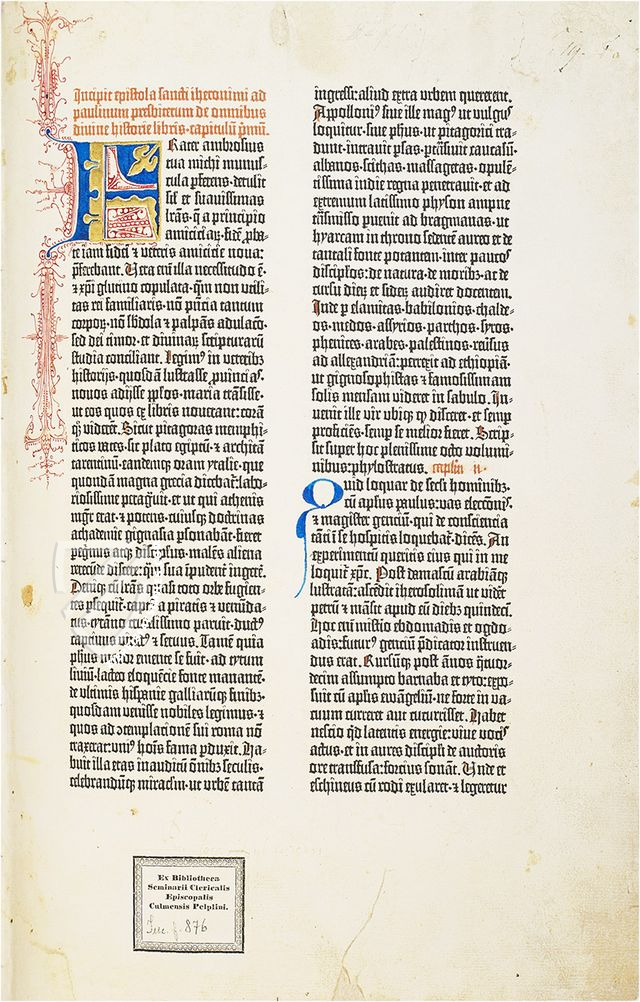
#1 Biblia Gutenberga
Language: English
(over 10,000€)
#2 Biblia Gutenberga
Language: English
(over 10,000€)
- Treatises / Secular Books
- Apocalypses / Beatus
- Astronomy / Astrology
- Bestiaries
- Bibles / Gospels
- Chronicles / History / Law
- Geography / Maps
- Saints' Lives
- Islam / Oriental
- Judaism / Hebrew
- Single Leaf Collections
- Leonardo da Vinci
- Literature / Poetry
- Liturgical Manuscripts
- Medicine / Botany / Alchemy
- Music
- Mythology / Prophecies
- Psalters
- Other Religious Books
- Games / Hunting
- Private Devotion Books
- Other Genres
- Afghanistan
- Armenia
- Austria
- Belgium
- Belize
- Bosnia and Herzegovina
- China
- Colombia
- Costa Rica
- Croatia
- Cyprus
- Czech Republic
- Denmark
- Egypt
- El Salvador
- Ethiopia
- France
- Germany
- Greece
- Guatemala
- Honduras
- Hungary
- India
- Iran
- Iraq
- Israel
- Italy
- Japan
- Jordan
- Kazakhstan
- Kyrgyzstan
- Lebanon
- Liechtenstein
- Luxembourg
- Mexico
- Morocco
- Netherlands
- Palestine
- Panama
- Peru
- Poland
- Portugal
- Romania
- Russia
- Serbia
- Spain
- Sri Lanka
- Sweden
- Switzerland
- Syria
- Tajikistan
- Turkey
- Turkmenistan
- Ukraine
- United Kingdom
- United States
- Uzbekistan
- Vatican City
- A. Oosthoek, van Holkema & Warendorf
- Aboca Museum
- Ajuntament de Valencia
- Akademie Verlag
- Akademische Druck- u. Verlagsanstalt (ADEVA)
- Aldo Ausilio Editore - Bottega d’Erasmo
- Alecto Historical Editions
- Alkuin Verlag
- Almqvist & Wiksell
- Amilcare Pizzi
- Andreas & Andreas Verlagsbuchhandlung
- Archa 90
- Archiv Verlag
- Archivi Edizioni
- Arnold Verlag
- ARS
- Ars Magna
- ArtCodex
- AyN Ediciones
- Azimuth Editions
- Badenia Verlag
- Bärenreiter-Verlag
- Belser Verlag
- Belser Verlag / WK Wertkontor
- Benziger Verlag
- Bernardinum Wydawnictwo
- BiblioGemma
- Biblioteca Apostolica Vaticana (Vaticanstadt, Vaticanstadt)
- Bibliotheca Palatina Faksimile Verlag
- Bibliotheca Rara
- Boydell & Brewer
- Bramante Edizioni
- Bredius Genootschap
- Brepols Publishers
- British Library
- C. Weckesser
- Caixa Catalunya
- Canesi
- CAPSA, Ars Scriptoria
- Caratzas Brothers, Publishers
- Carus Verlag
- Casamassima Libri
- Centrum Cartographie Verlag GmbH
- Chavane Verlag
- Christian Brandstätter Verlag
- Circulo Cientifico
- Club Bibliófilo Versol
- Club du Livre
- CM Editores
- Collegium Graphicum
- Collezione Apocrifa Da Vinci
- Comissão Nacional para as Comemorações dos Descobrimentos Portugueses
- Coron Verlag
- Corvina
- CTHS
- D. S. Brewer
- Damon
- De Agostini/UTET
- De Nederlandsche Boekhandel
- De Schutter
- Deuschle & Stemmle
- Deutscher Verlag für Kunstwissenschaft
- DIAMM
- Droz
- E. Schreiber Graphische Kunstanstalten
- Ediciones Boreal
- Ediciones Grial
- Ediclube
- Edições Inapa
- Edilan
- Editalia
- Edition Deuschle
- Edition Georg Popp
- Edition Leipzig
- Edition Libri Illustri
- Editiones Reales Sitios S. L.
- Éditions de l'Oiseau Lyre
- Editions Medicina Rara
- Editorial Casariego
- Editorial Mintzoa
- Editrice Antenore
- Editrice Velar
- Edizioni Edison
- Egeria, S.L.
- Eikon Editores
- Electa
- Emery Walker Limited
- Enciclopèdia Catalana
- Eos-Verlag
- Ephesus Publishing
- Ernst Battenberg
- Eugrammia Press
- Extraordinary Editions
- Fackelverlag
- Facsimila Art & Edition
- Facsimile Editions Ltd.
- Facsimilia Art & Edition Ebert KG
- Faksimile Verlag
- Feuermann Verlag
- Folger Shakespeare Library
- Franco Cosimo Panini Editore
- Friedrich Wittig Verlag
- Fundación Hullera Vasco-Leonesa
- G. Braziller
- Gabriele Mazzotta Editore
- Gebr. Mann Verlag
- Gesellschaft für graphische Industrie
- Getty Research Institute
- Giovanni Domenico de Rossi
- Giunti Editore
- Graffiti
- Grafica European Center of Fine Arts
- Guido Pressler
- Guillermo Blazquez
- Gustav Kiepenheuer
- H. N. Abrams
- Harrassowitz
- Harvard University Press
- Helikon
- Hendrickson Publishers
- Henning Oppermann
- Herder Verlag
- Hes & De Graaf Publishers
- Hoepli
- Holbein-Verlag
- Houghton Library
- Hugo Schmidt Verlag
- Idion Verlag
- Il Bulino, edizioni d'arte
- ILte
- Imago
- Insel Verlag
- Insel-Verlag Anton Kippenberger
- Instituto de Estudios Altoaragoneses
- Instituto Nacional de Antropología e Historia
- Introligatornia Budnik Jerzy
- Istituto dell'Enciclopedia Italiana - Treccani
- Istituto Ellenico di Studi Bizantini e Postbizantini
- Istituto Geografico De Agostini
- Istituto Poligrafico e Zecca dello Stato
- Italarte Art Establishments
- Jan Thorbecke Verlag
- Johnson Reprint Corporation
- Josef Stocker
- Josef Stocker-Schmid
- Jugoslavija
- Karl W. Hiersemann
- Kasper Straube
- Kaydeda Ediciones
- Kindler Verlag / Coron Verlag
- Kodansha International Ltd.
- Konrad Kölbl Verlag
- Kurt Wolff Verlag
- La Liberia dello Stato
- La Linea Editrice
- La Meta Editore
- Lambert Schneider
- Landeskreditbank Baden-Württemberg
- Leo S. Olschki
- Les Incunables
- Liber Artis
- Library of Congress
- Libreria Musicale Italiana
- Lichtdruck
- Lito Immagine Editore
- Lumen Artis
- Lund Humphries
- M. Moleiro Editor
- Maison des Sciences de l'homme et de la société de Poitiers
- Manuscriptum
- Martinus Nijhoff
- Maruzen-Yushodo Co. Ltd.
- MASA
- Massada Publishers
- McGraw-Hill
- Metropolitan Museum of Art
- Militos
- Millennium Liber
- Müller & Schindler
- Nahar - Stavit
- Nahar and Steimatzky
- National Library of Wales
- Neri Pozza
- Nova Charta
- Oceanum Verlag
- Odeon
- Orbis Mediaevalis
- Orbis Pictus
- Österreichische Staatsdruckerei
- Oxford University Press
- Pageant Books
- Parzellers Buchverlag
- Patrimonio Ediciones
- Pattloch Verlag
- PIAF
- Pieper Verlag
- Plon-Nourrit et cie
- Poligrafiche Bolis
- Presses Universitaires de Strasbourg
- Prestel Verlag
- Princeton University Press
- Prisma Verlag
- Priuli & Verlucca, editori
- Pro Sport Verlag
- Propyläen Verlag
- Pytheas Books
- Quaternio Verlag Luzern
- Reales Sitios
- Recht-Verlag
- Reichert Verlag
- Reichsdruckerei
- Reprint Verlag
- Riehn & Reusch
- Roberto Vattori Editore
- Rosenkilde and Bagger
- Roxburghe Club
- Salerno Editrice
- Saltellus Press
- Sandoz
- Sarajevo Svjetlost
- Schöck ArtPrint Kft.
- Schulsinger Brothers
- Scolar Press
- Scrinium
- Scripta Maneant
- Scriptorium
- Shazar
- Siloé, arte y bibliofilia
- SISMEL - Edizioni del Galluzzo
- Sociedad Mexicana de Antropología
- Société des Bibliophiles & Iconophiles de Belgique
- Soncin Publishing
- Sorli Ediciones
- Stainer and Bell
- Studer
- Styria Verlag
- Sumptibus Pragopress
- Szegedi Tudomànyegyetem
- Taberna Libraria
- Tarshish Books
- Taschen
- Tempus Libri
- Testimonio Compañía Editorial
- Thames and Hudson
- The Clear Vue Publishing Partnership Limited
- The Facsimile Codex
- The Folio Society
- The Marquess of Normanby
- The Richard III and Yorkist History Trust
- Tip.Le.Co
- TouchArt
- TREC Publishing House
- TRI Publishing Co.
- Trident Editore
- Tuliba Collection
- Typis Regiae Officinae Polygraphicae
- Union Verlag Berlin
- Universidad de Granada
- University of California Press
- University of Chicago Press
- Urs Graf
- Vallecchi
- Van Wijnen
- VCH, Acta Humaniora
- VDI Verlag
- VEB Deutscher Verlag für Musik
- Verlag Anton Pustet / Andreas Verlag
- Verlag Bibliophile Drucke Josef Stocker
- Verlag der Münchner Drucke
- Verlag für Regionalgeschichte
- Verlag Styria
- Vicent Garcia Editores
- W. Turnowski Ltd.
- W. Turnowsky
- Waanders Printers
- Wiener Mechitharisten-Congregation (Wien, Österreich)
- Wissenschaftliche Buchgesellschaft
- Wissenschaftliche Verlagsgesellschaft
- Wydawnictwo Dolnoslaskie
- Xuntanza Editorial
- Zakład Narodowy
- Zollikofer AG

